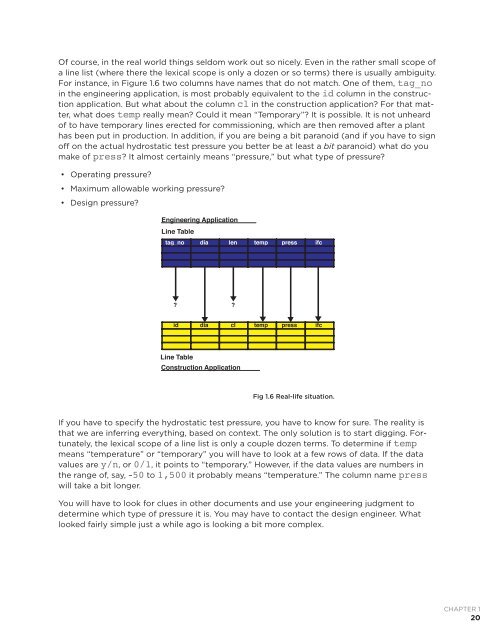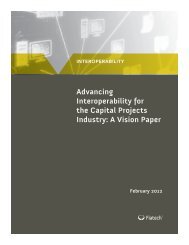An Introduction to ISO 15926 November 2011 - iRINGToday
An Introduction to ISO 15926 November 2011 - iRINGToday
An Introduction to ISO 15926 November 2011 - iRINGToday
Create successful ePaper yourself
Turn your PDF publications into a flip-book with our unique Google optimized e-Paper software.
Of course, in the real world things seldom work out so nicely. Even in the rather small scope of<br />
a line list (where there the lexical scope is only a dozen or so terms) there is usually ambiguity.<br />
For instance, in Figure 1.6 two columns have names that do not match. One of them, tag_no<br />
in the engineering application, is most probably equivalent <strong>to</strong> the id column in the construction<br />
application. But what about the column cl in the construction application? For that matter,<br />
what does temp really mean? Could it mean “Temporary”? It is possible. It is not unheard<br />
of <strong>to</strong> have temporary lines erected for commissioning, which are then removed after a plant<br />
has been put in production. In addition, if you are being a bit paranoid (and if you have <strong>to</strong> sign<br />
off on the actual hydrostatic test pressure you better be at least a bit paranoid) what do you<br />
make of press? It almost certainly means “pressure,” but what type of pressure?<br />
• Operating pressure?<br />
• Maximum allowable working pressure?<br />
• Design pressure?<br />
Engineering Application<br />
Line Table<br />
tag_no dia len temp press ifc<br />
?<br />
?<br />
id dia cl temp press ifc<br />
Line Table<br />
?<br />
?<br />
Construction Application<br />
Fig 1.6 Real-life situation.<br />
If you have <strong>to</strong> specify the hydrostatic test pressure, you have <strong>to</strong> know for sure. The reality is<br />
that we are inferring everything, based on context. The only solution is <strong>to</strong> start digging. Fortunately,<br />
the lexical scope of a line list is only a couple dozen terms. To determine if temp<br />
means “temperature” or “temporary” you will have <strong>to</strong> look at a few rows of data. If the data<br />
values are y/n, or 0/1, it points <strong>to</strong> “temporary.” However, if the data values are numbers in<br />
the range of, say, –50 <strong>to</strong> 1,500 it probably means “temperature.” The column name press<br />
will take a bit longer.<br />
You will have <strong>to</strong> look for clues in other documents and use your engineering judgment <strong>to</strong><br />
determine which type of pressure it is. You may have <strong>to</strong> contact the design engineer. What<br />
looked fairly simple just a while ago is looking a bit more complex.<br />
CHAPTER 1<br />
20



